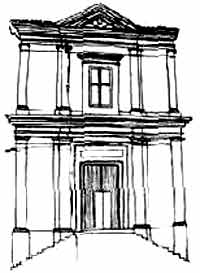 In the new premises the monks continued to call themselves of "Santa Maria of Maniace" and have their abbots elected regularly (the last one was friar Giacomo Cimbali in 1900-1904). In the new premises the monks continued to call themselves of "Santa Maria of Maniace" and have their abbots elected regularly (the last one was friar Giacomo Cimbali in 1900-1904).
In Bronte they transported their objects of cult, their relics and, writes the Radice, also the Byzantine icon of Santa Maria Of Maniace (even if a writing in Latin, present on the painting, make you think that the one preserved in San Blandano could be a copy and not the original). The lodgings were completed in 1708 around the church and in 1784, as informs us an inscription inside, king Ferdinand IV, in consequence of the concession to the admiral Horatio Nelson of the ancient Maniace Abbey and all its properties, decreed the definitive transfer of the Abbey ("Ecclesia Sanctae Mariae de Maniachio regio diplomate Ferdinandi IV°, uc traslata"). The church was rebuilt from the foundations in 1821 (on the door architrave is written "Santa Maria a fundamentis quasi aedificata, anno domini 1824"). The Basilian monastery was suppressed following the laws of 1886 which sanctioned the alienation of the ecclesiastical possessions (with it had been also cancelled the female seclusion monastery of Santa Scolastica adjacent to the San Silvestro church).
The monastery, at the end of the XVIII century, was demolished and changed, for a short period, to a municipal house. It doesn't exist any longer.
The inside
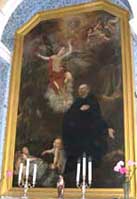 The inside of the church, to a rectangular only nave, is marked on top by a big frame that starting from the choristers area, above the entry foyer, ends up above the major altar proposing again the motif of the façade tympanum. The inside of the church, to a rectangular only nave, is marked on top by a big frame that starting from the choristers area, above the entry foyer, ends up above the major altar proposing again the motif of the façade tympanum.
To the walls four niches with arches just mentioned for the minor altars. On the first to the right there is the picture showing San Giovanni Damasceno and to the left San Lorenzo left from Frazzanò, both of 1827 work by the brontese painter Giuseppe Dinaro (1795-1848). On the second altar to the right there is a glass covered wooden reliquary where are preserved the martyrs' bones. Ab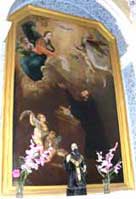 ove the major altar, inside a decoration of baroque style (draped cloth with small plaster angels in high-relief), is placed the Byzantine icon of the Madonna With The Child. ove the major altar, inside a decoration of baroque style (draped cloth with small plaster angels in high-relief), is placed the Byzantine icon of the Madonna With The Child. The ancient origins of the church and an extensive devotion of the Brontes towards San Blandano are also demonstrated by the writings of the marriage and baptismal registers (the first mention of the church reported there is from 1693) where it appears that many were the Brontes who had the name of Blandano, nowadays it has completely disappeared and forgotten. San Blandano (or Brandano) is the church in Bronte richest in relics; some of these were also lost during the construction works of the adjacent carabinieri barracks; the others should be kept in the sacristy of the Church. 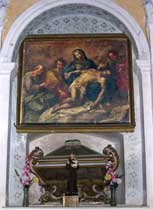 Among these are preserved relics of Santa Caritosa, Sant'Antimio martyr, Santa Pulcheria, Santa Anastasia, San Gregorio Taumaturgo, other relics and also some particles of the ribs of the Blessed Guglielmo abbot of Maniace. Among these are preserved relics of Santa Caritosa, Sant'Antimio martyr, Santa Pulcheria, Santa Anastasia, San Gregorio Taumaturgo, other relics and also some particles of the ribs of the Blessed Guglielmo abbot of Maniace.
«His body - writes B. Radice -, minus the head, which is said to be in Patti, the arms, feet and entrails is still preserved behind the high altar of the church of the monastery of Maniace. But of S. Blandano or Brentano, an Irish Benedictine, who lived in Scotland around the year 570, remembered in the Roman Martyrology on May 16, and of whom the medieval legend narrates that with his mortal body he visited hell, and for seven years he sailed the Ocean in search of the earthly paradise, neither effigy nor altar exists in its church." 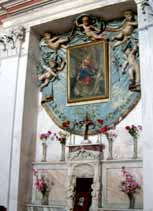 A curiosity: Card. speaks instead of Ireland. Antonino Saverio De Luca who among his innumerable works dedicated to the homeland of San Blandano «Religious and political events in Ireland from 1536 to 1829», a book begun in 1929, at the time long awaited by the religious environment and by scholars of 'over the channel, but which was never published. A curiosity: Card. speaks instead of Ireland. Antonino Saverio De Luca who among his innumerable works dedicated to the homeland of San Blandano «Religious and political events in Ireland from 1536 to 1829», a book begun in 1929, at the time long awaited by the religious environment and by scholars of 'over the channel, but which was never published.
The original manuscript is preserved in the library of the Real Collegio Capizzi. Finally, Radice reminds us that «opposite the church of S. Blandano stood a hospice of the Jesuit fathers, as can be seen from the acronym "I. H. S." in the arching of the door architrave".
|